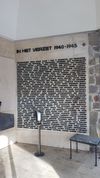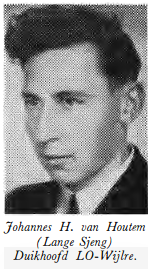

|
|
|
|
|
|
right wall, row 39 #05

Limburg 1940-1945,
Main Menu
The fallen resistance people in Limburg
Johannes Hubertus van Houtem (Lange Sjeng)
∗ 16-06-1917 Mechelen † 28-05-1945 Lübeck (27)
- Aid to People in Hiding L.O. - Wittem - Local contacts -
- Het Grote Gebod
- Dr. F. Cammaert, Het Verborgen Front – Geschiedenis van de georganiseerde illegaliteit in de provincie Limburg tijdens de Tweede Wereldoorlog. Doctorale scriptie 1994, Groningen
 6. De Landelijke Organisatie voor hulp aan onderduikers • § VIII.7. District Gulpen, p.691 ff.
6. De Landelijke Organisatie voor hulp aan onderduikers • § VIII.7. District Gulpen, p.691 ff. - Deppner-executies / Erich Deppner, Wikipedia • Nederlands • Deutsch
- Totenmärsche, Wikipedia • Nederlands • Deutsch • English • Français • Español
- 1. OpenStreetMap Hospital Kronsforder Allee
2. Archief Oorlogsgravenstichting (@ Nationaal archief), Dossier • Jan van Houtem #12 - OpenStreetMap Grabow-Below
- Lübeck: Vorwerker Friedhof, Wikipedia • Deutsch
- Verzetsmonument op de Eyserlinde, Wylré
- Erelijst 1940-1945
- Oorlogsgravenstichting.nl
Jan van Houtem from Wylré was an auto mechanic an there local contact person between the people in hiding, the so called divers and the subdistrict of the L.O. (local contact: duikhoofd or divers’ chief). There he had the nickname Lange Sjeng (Long John). [1]
He was arrested on July 21, 1944 at the Strike of Wittem. The Strike of Wittem is also described in detail by Cammaert in the paragraph about the LO district of Gulpen. [2]
Via the Maastricht prison, he was taken to the Herzogenbusch concentration camp. This is also called camp Vught. In the first days of September 1944, masses of prisoners were murdered in the camp Vught. This later became known as the Deppner executions. [3]
The remaining prisoners were deported to Germany, including Jan van Houtem.
His file in the OGS contains a document that reads as follows: Arrested by the SD in Maastricht on 21 July 1944 for illegal work in Wylré as divers’ chief of the LO in Gewest of Limburg, district of Gulpen. After a stay in Maastricht prison, sent to Vught concentration camp on August 1, 1944, and to Oranienburg-Sachsenhausen concentration camp on September 6, 1944. Later evcacuation march [4] west until the forest of Below near Wittstock. Liberated and transported to Lübeck by the Swedish Red Cross. There admitted to the emergency hospital Landesversicherungsanstalt, Kronsforder Allee [5.1], on May 6, 1945, cared for by Dr. Schinagel and Sanitäter (paramedic) Max Geissler. [5.2]
The village of Grabow-Below, where this death march [4] was liberated by Soviet troops, is halfway between Oranienburg and Lübeck. [6]
His condition was very bad at the time. On May 6, 1945, the Swedish Red Cross took him to an emergency hospital in Lübeck, which had been liberated by the British on May 2. He died there on the 28th.
He was first buried in the "Vorwerker Friedhof" in Lübeck. Almost 3,000 dead from concentration camps, Germans, Dutch, Poles, Estonians, Latvians, Ukrainians and Russians lie in this cemetery. [7]
He was reburied in the Catholic cemetery of Wylré, grave 1-9. [10]
His name is on the Resistance memorial Op de Eyserlinde near Wylré. [8]
This person is listed in the “Erelijst 1940-1945” (Honor Roll of the Dutch Parliament). [9]
Footnotes
